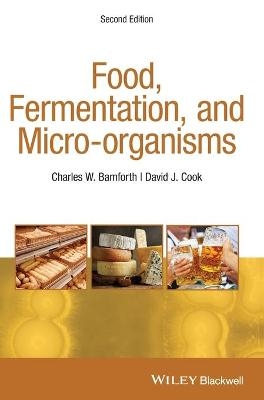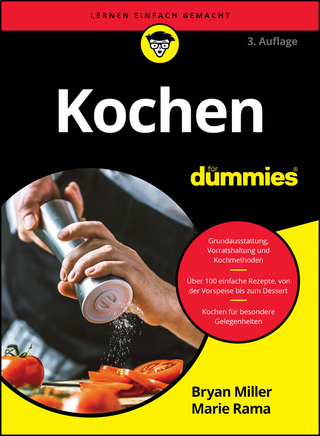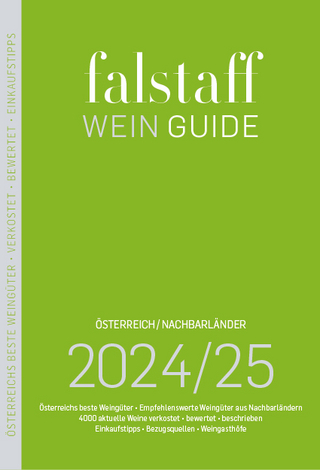
Food, Fermentation, and Micro-organisms
Wiley-Blackwell (Verlag)
978-1-4051-9872-1 (ISBN)
In this updated and expanded second edition of Food, Fermentation, and Micro-organisms, all known food applications of fermentation are examined. Beginning with the science underpinning food fermentations, the author looks at the relevant aspects of microbiology and microbial physiology before covering individual foodstuffs and the role of fermentation in their production, as well as the possibilities that exist for fermentation’s future development and application. Many chapters, particularly those on cheese, meat, fish, bread, and yoghurt, now feature expanded content and additional illustrations. Furthermore, a newly included chapter looks at indigenous alcoholic beverages.
Food, Fermentation, and Micro-organisms, Second Edition is a comprehensive guide for all food scientists, technologists, and microbiologists working in the food industry and academia today. The book will be an important addition to libraries in food companies, research establishments, and universities where food studies, food science, food technology and microbiology are studied and taught.
Professor Charles W. Bamforth, Head of Malting and Brewing Science, Department of Food Science and Technology, University of California, Davis, USA. Professor David J. Cook, AB InBev Chair in Brewing Science, School of Biosciences, University of Nottingham, Loughborough, UK.
Preface xiii
Introduction 1
Bibliography 3
1 The Science Underpinning Food Fermentations 5
1.1 Micro‐Organisms 6
1.2 Microbial Metabolism 8
1.2.1 Nutritional Needs 9
1.2.2 Environmental Impacts 11
1.2.2.1 Temperature 11
1.2.2.2 pH 14
1.2.2.3 Water Activity 14
1.2.2.4 Oxygen 17
1.2.2.5 Radiation 19
1.2.2.6 Hydrostatic Pressure 19
1.2.3 Controlling or Inhibiting Growth of Micro‐organisms 19
1.2.3.1 Heating 19
1.2.3.2 Cooling 20
1.2.3.3 Drying 20
1.2.3.4 Irradiation 20
1.2.3.5 Filtration 20
1.2.3.6 Chemical Agents 21
1.2.4 Metabolic Events 22
1.2.4.1 Catabolism 22
1.2.4.2 Anabolism 25
1.3 The Origins of the Organisms Employed in Food Fermentations 28
1.4 Some of the Major Micro‐Organisms in This Book 30
1.4.1 Yeast 32
1.4.2 Lactic Acid Bacteria 35
1.4.2.1 Lactococcus 36
1.4.2.2 Leuconostoc 36
1.4.2.3 Streptococcus 36
1.4.2.4 Lactobacillus 36
1.4.2.5 Pediococci 36
1.4.2.6 Enterococcus 36
1.5 Providing the Growth Medium for the Organisms 37
1.6 Fermenters 37
1.7 Downstream Processing 37
1.8 Some General Issues for a Number of Foodstuffs 38
1.8.1 Non‐enzymatic Browning 38
1.8.2 Enzymatic Browning 40
1.8.3 Caramelisation of Sugars 41
1.8.4 Antioxidants 41
Bibliography 42
2 Beer 43
2.1 Overview of Malting and Brewing 43
2.2 Barley and Malt Production 46
2.3 Mashing: The Production of Sweet Wort 53
2.3.1 Milling 53
2.3.2 Mashing 55
2.3.3 Adjuncts 59
2.3.4 Wort Separation 60
2.3.4.1 Lauter Tun 60
2.3.4.2 Mash Filters 61
2.4 Water 61
2.5 Hops 64
2.6 Wort Boiling and Clarification 66
2.7 Wort Cooling 66
2.8 Yeast 67
2.9 Brewery Fermentations 73
2.10 Filtration 76
2.11 The Stabilisation of Beer 77
2.12 Gas Control 77
2.13 Packaging 78
2.13.1 Filling Bottles and Cans 79
2.13.2 Filling Kegs 79
2.14 The Quality of Beer 80
2.14.1 Flavour 80
2.14.2 Foam 88
2.14.3 Gushing 88
2.15 Spoilage of Beer 88
2.16 Beer Styles 90
Bibliography 90
3 Wine 93
3.1 Grapes 93
3.2 Grape Processing 97
3.2.1 Stemming and Crushing 98
3.2.2 Drainers and Presses 99
3.3 Fermentation 101
3.3.1 Juice 101
3.3.2 Yeast 102
3.4 Clarification 103
3.5 Filtration 104
3.6 Stabilisation 104
3.7 The Use of Other Micro‐Organisms in Wine Production 104
3.8 Champagne/Sparkling Wine 105
3.9 Ageing 106
3.10 Packaging 108
3.11 Taints and Gushing 108
3.12 The Composition of Wine 108
3.13 Classifications of Wine 108
3.14 Wine Evaluation 109
Bibliography 110
4 Fortified Wines 111
4.1 Sherry 112
4.2 Port 113
4.3 Madeira 114
Bibliography 115
5 Cider 117
5.1 Apples 118
5.2 Milling and Pressing 121
5.3 Fermentation 122
5.4 Cider Colour and Flavour 125
5.5 Post‐ Fermentation Processes 126
5.6 Problems With Cider 126
5.7 Perry 129
Bibliography 130
6 Distilled Alcoholic Beverages 131
6.1 Whisk(e)y 131
6.1.1 Distillation 133
6.1.2 Whiskey Variants 137
6.2 Cognac 138
6.3 Armagnac and Wine Spirits 138
6.4 Rum 140
Bibliography 141
7 Vodka, Flavoured Spirits and Liqueurs 143
7.1 Vodka 143
7.2 Gin 144
7.3 Liqueurs 145
Bibliography 153
8 Sake 155
8.1 Sake Brewing 159
8.1.1 Polishing, Steeping and Steaming 160
8.1.2 Making Koji 160
8.1.3 Making Moto 160
8.1.4 Moromi 161
8.1.5 Modern Sake Making 162
8.2 The Flavour of Sake 163
8.3 Types of Sake 163
8.4 Serving Temperature 164
Bibliography 164
9 Vinegar 165
9.1 Vinegar‐Making Processes 166
9.2 Malt Vinegar 168
9.3 Wine Vinegar 168
9.4 Balsamic Vinegar 168
9.5 Other Vinegars 169
9.6 Chemical Synthesis of Vinegar 169
Bibliography 171
10 Cheese 173
10.1 Milk 175
10.2 The Culturing of Milk with Lactic Acid Bacteria 177
10.3 Milk Clotting 178
10.4 Whey Expulsion 178
10.5 Curd Handling 179
10.6 The Production of Processed Cheese 179
10.7 The Maturation of Cheese 179
Bibliography 182
11 Yoghurt and Other Fermented Milk Products 183
Bibliography 186
12 Bread 187
12.1 Flour 188
12.2 Water 188
12.3 Salt 188
12.4 Fat 188
12.5 Sugar 189
12.6 Leavening 189
12.7 Additives 189
12.8 Fermentation 191
12.9 Dough Acidification 191
12.10 Formation of Dough 191
12.11 Leavening of Doughs 192
12.12 Processing of Fermented Doughs 193
12.13 Baking 193
12.14 Bread Flavour 194
12.15 Staling of Bread 195
12.16 Bread Composition 195
Bibliography 195
13 Meat 197
13.1 Fermented Sausage 197
13.1.1 The Role of Components of the Curing Mixture 197
13.1.2 Meat Fermentation 198
13.2 Raw Hams 199
Bibliography 200
14 Indigenous Fermented Foods 201
14.1 Soy Sauce 201
14.1.1 Mash (Moromi) Stage 204
14.2 Miso 205
14.3 Natto 208
Bibliography 208
15 Vegetable Fermentations 211
15.1 Factors Impacting Vegetable Fermentations 211
15.2 Cucumbers 211
15.3 Cabbage 213
15.4 Olives 214
15.4.1 Untreated Naturally Ripe Black Olives in Brine 214
15.4.2 Lye‐Treated Green Olives in Brine 215
Bibliography 215
16 Cocoa 217
16.1 Roasting 220
16.2 Production of Cocoa Mass or Chocolate Liquor 220
16.3 Cocoa Butter 221
16.4 Production of Chocolate 221
Bibliography 222
17 Microbial Biomass Protein 223
17.1 Production and Properties of Quorn 223
Bibliography 224
18 Miscellaneous Fermentation Products 225
Bibliography 234
Index 235
| Erscheinungsdatum | 24.04.2019 |
|---|---|
| Verlagsort | Hoboken |
| Sprache | englisch |
| Maße | 173 x 246 mm |
| Gewicht | 522 g |
| Themenwelt | Sachbuch/Ratgeber ► Essen / Trinken |
| Technik | |
| Weitere Fachgebiete ► Land- / Forstwirtschaft / Fischerei | |
| ISBN-10 | 1-4051-9872-9 / 1405198729 |
| ISBN-13 | 978-1-4051-9872-1 / 9781405198721 |
| Zustand | Neuware |
| Haben Sie eine Frage zum Produkt? |
aus dem Bereich


